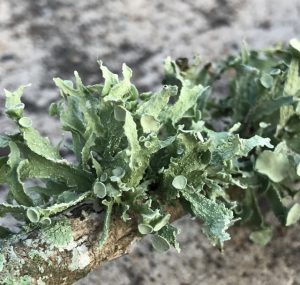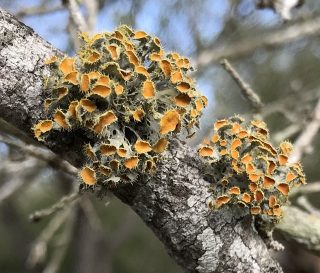“Lichens are a complex community of microbiome,” stated Dr. Manuela Dal Forno, research botanist at the Botanical Research Institute of Texas in Fort Worth.

Forno was one of over 90 speakers during this year’s annual Texas Master Naturalist Conference held virtually in October. Her lecture was entitled, “Lichens 101: Everything you need to make lichens part of your naturalist life.”
Lichens are a complex life form that is a symbiotic partnership of two separate organisms, a fungus and an alga. The dominant partner is the fungus, which gives the lichen the majority of its characteristics. Lichen do not have any roots, stems or leaves; their chloroplasts are contained only in the algae on the top surface of the lichen. Lichen are not mosses.
Forno offered a formula:
Multi-species symbiosis — fungus + algae + microbiome = lichen thallus
Brief terminology is warranted for better understanding of these unique and beautiful forms of nature.
Biome, a major type of community of distinctive plants and animals living together in a particular climate and physical environment.
Microbiome, a community of microorganisms such as bacteria, fungi and viruses that inhabit a particular environment.
Thallus, a plant body that is not differentiated into stem and leaves and lacks true roots and a vascular system. Thalli are typical of algae, fungi, lichens, and some liverworts.
Chloroplast, a plastid (organelles containing pigment or food) that contains chlorophyll and in which photosynthesis takes place.
Bacteria was first proposed to be part of lichens in the 1930s; it was not until the 2000s that researchers started using DNA techniques to prove the concept of lichens as multi-symbioses or meta-organisms. This recent research corroborates the bacterial associations with lichens’ symbioses that supports the notion of this multi-species symbiosis, according to Forno.
Lichen diversity is promoted by good air quality, habitat continuity, availability of preferred substrates, and favorable climate.
Just about anything that doesn’t move can be a suitable substrate like trees, rocks, soil, houses, tombstones, old cars, and farm equipment. The most common natural substrates are trees, rocks, and soil. Each substrate must have the individual components in the right amounts that growing lichen need: water, air, nutrients, and light. The main nutrients needed in order for lichens to survive and grow are nitrogen, carbon, and oxygen.
There are three forms of lichen: crustose, which is a flat type of growth, foliose, leaf-like but prostrate, and fruticose, which is bush-like and erect or a hanging type growth. Historically, compounds unique to lichens have been used in perfume additives, fiber dyes, tanning agents, poisons, and medicines in some countries.
One lichen prevalent in the Valley can often be seen on branches or limbs of the honey mesquite. It is Ramalina complanata lichen, a foliose, or leafy form. It is grey to grey-green in color.

Another lichen found on a mesquite branch in Harlingen’s Hugh Ramsey Nature Park is Teloschistes chrysophthalmus, golden-eye lichen, also a fruticose lichen; it has branching lobes. Their sexual structures, the apothecia (spore-bearing structure), are bright-orange with spiny projections (cilia) situated around the rim. It can be found globally most often along coastal areas.
Lichens are not parasitic to host trees, though heavy lichen growth may restrict gas exchanges from the limb and can block light from reaching the plant’s surface. Lichen growth can indicate that a tree has experienced stress that has weakened the tree which can encourage lichen development. Lichen growth can indicate a tree needs attention.